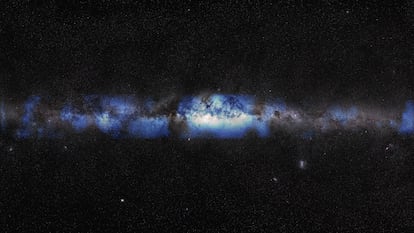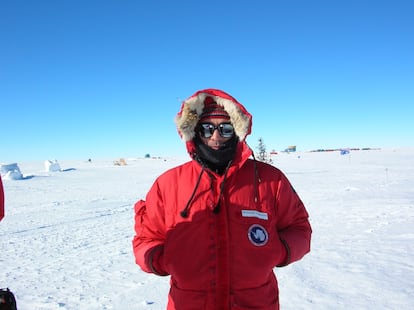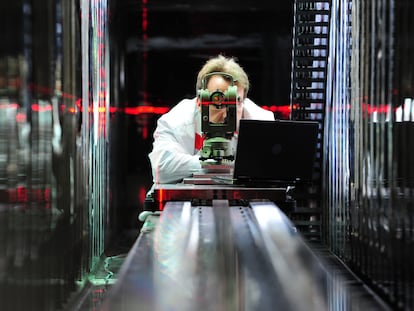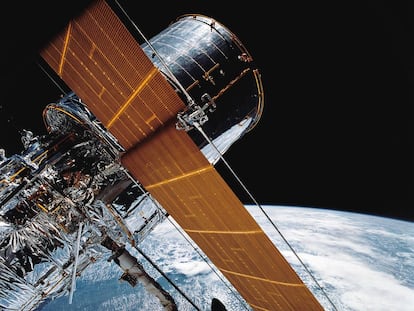A telescope in Antarctica detects the first galactic neutrinos
The IceCube experiment confirms that there are unknown bodies within the Milky Way capable of generating the highest-energy phenomena in the universe

An enormous telescope below the ice of the South Pole has detected neutrinos from our galaxy, the Milky Way. The discovery is the confirmation of a phenomena awaited for years. It proves that our own cosmic neighborhood contains unknown bodies capable of producing the highest-energy particles in the universe.
Neutrinos are the most common particles in the cosmos. Every second, some 100 billion pass through our bodies without our noticing. These ghostly particles do not have electric charge or mass. Most of them cross the Earth without leaving a trace. But some end up interacting with atoms and producing a spark of blue light that can determine their origin.
The IceCube telescope is embedded in a cubic kilometer of Antarctic ice. It includes more than 5,000 spherical sensors that can capture the bursts of light that the neutrinos leave behind. In 2013, the observatory discovered the first two neutrinos from outside of our galaxy. They were named Epi and Blas, and they inaugurated a new era in astronomy, though it could not be determined exactly where they came from.
In 2017 and 2022, several dozen more neutrinos were captured, allowing the identification of the first two sources outside of our galaxy: two black holes in which millions of stars the size of the Sun could fit. In the first case, the neutrinos had traveled almost at the speed of light for more than four billion years from the faraway galaxy TXS 0506+065. In the second, they came from Messier 77, a galaxy just 47 million lightyears away from our solar system.
Neutrinos are associated with cosmic rays, clusters of particles that have the highest charge of any in the universe. In 1993, a telescope in Utah captured the most powerful known particle of this type. It traveled close to the speed of light, and its energy was millions of times more than the upper limit of the most powerful particle accelerator in the world, the lHC. It was named the OMG particle.
Now, IceCube has discovered hundreds of neutrinos from the center of our galaxy, 25,000 lightyears away, and with energy levels 10,000 times greater than a particle accelerator, explains Ignacio Taboada, spokesperson for the IceCube telescope. “Discovering these galactic neutrinos should be easy, but it turns out that the Milky Way does not produce many. We have finally managed to capture them, and so we know that in our cosmic environment there are also objects capable of producing them,” explains Taboada, a Venezuelan researcher who has worked for IceCube since its construction in 2010. The discovery is published today in Science magazine.

IceCube is located below the Amundsen-Scott South Pole station, where the average temperature is 50 degrees below zero. During the arctic winter, a period of six months during which the sun never rises, only two people remain on the base to keep IceCube functioning. Meanwhile , a team of more than 300 scientists of more than 12 countries can access the device’s data in real time.
Today’s discovery is the result of an artificial intelligence that has analyzed one billion signals of neutrinos captured between 2011 and 2022 and has selected the few hundred that come from the Milky Way. Juanan Aguilar, astroparticle physicist who is part of the IceCube team, explains that “before, less-precise statistical models were used to analyze the signals captured by the telescope.’ The new tools, based on neural networks, can clean up the noise produced by other particles, staying with “the signals that come from inside the galaxy.”
The Milky Way has the shape of a flattened spiral, and the signals discovered seem to come from the edge. The data of IceCube shows that there is a sort of foggy cloud of neutrinos that extends through the galaxy’s center. They may be one or several sources of neutrinos. One of them may be Sagittarius A*, a black hole with a mass equivalent to four million Suns, in the center of the galaxy. It is also possible that there may be other unknown objects that produce cosmic rays and neutrinos, like a black hole in the process of swallowing up a nearby star

“The discovery of IceCube shows that in our own galaxy, there must be enormous particle accelerators” equivalent to those that had previously been detected in other galaxies, explains Francisco Salesa, a scientist at the Institute of Corpuscular Physics in Valencia. This month, the Antares neutrino detector, located beneath the Mediterranean Sea off of the coast of Toulon, France, captured a signal of galactic neutrinos. “The reliability of that signal was two sigma, which means there was a possibility within 100 that the signal was an error,” Salesa explains. “The observation of IceCube is 4.5 sigma, a possibility of error among 10 million.” It is much more reliable, but it does not reach the threshold of qualifying as a discovery, which requires five sigma: a possibility among 3.5 million.
Now, a world race begins to identify the origin of the galactic neutrinos. IceCube, funded primarily by the United States, will continue functioning and could achieve it. But its location in the Southern Hemisphere means that the center of the galaxy is just above it, which introduces noise caused by other elemental particles produced in the atmosphere, the Sun and other objects. Currently under construction is KM3Net, a new submarine telescope in the Mediterranean with two headquarters, Arca and Orca, close to Toulon and Sicily, Italy. Its location in the northern hemisphere serves as a filter, allowing it to detect more precisely the origin of galactic neutrinos.
Sign up for our weekly newsletter to get more English-language news coverage from EL PAÍS USA Edition
Tu suscripción se está usando en otro dispositivo
¿Quieres añadir otro usuario a tu suscripción?
Si continúas leyendo en este dispositivo, no se podrá leer en el otro.
FlechaTu suscripción se está usando en otro dispositivo y solo puedes acceder a EL PAÍS desde un dispositivo a la vez.
Si quieres compartir tu cuenta, cambia tu suscripción a la modalidad Premium, así podrás añadir otro usuario. Cada uno accederá con su propia cuenta de email, lo que os permitirá personalizar vuestra experiencia en EL PAÍS.
¿Tienes una suscripción de empresa? Accede aquí para contratar más cuentas.
En el caso de no saber quién está usando tu cuenta, te recomendamos cambiar tu contraseña aquí.
Si decides continuar compartiendo tu cuenta, este mensaje se mostrará en tu dispositivo y en el de la otra persona que está usando tu cuenta de forma indefinida, afectando a tu experiencia de lectura. Puedes consultar aquí los términos y condiciones de la suscripción digital.











































